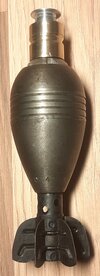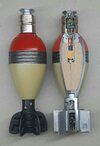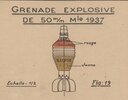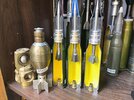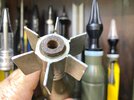pzgr40
Well-Known Member
Cutaway model of a French 50mm mortar shell for the ‘Lance grenades de 50mm Mle 1937’ light mortar. The weapon was designed in 1937, taken into service in 1939 as a platoon support weapon, meant to replace the obsolete World war one VB rifle grenade.
The barrel was fixed at 45 degrees and range was adjusted by rotating a gas escape ring at the lower side of the barrel.
The complete weapon weighed 3,6 kg and had a barrel length of 415mm.
At first, the french army ordered 21.950 of these 50mm mortars, but this was later adjusted to 50.000 mortars. However, in June 1940 only 2900 were produced. the German army captured these mortars and named it the ‘granatenwerfer 203 (f)’ and issued them to occupation troops. Many shells however ended up as landmines; the tail removed and the body placed in a cast pyramid shaped concrete block, and the impact fuze replaced by a Buck fuze (Buck zunder).
The shell weighs 430 grams and has a maximum range of 460 mtrs (1510 ft), the effective range however is 70 mtrs (230 ft). The Vo of the projectile is 70 mtrs/sec (230 ft/sec). the projectile had an explosive charge consisting of 120 grams (4.2 Oz) of Amatol or TNT.
The length of the complete shell is 164 mm (6.45 inch).
The impact fuze used on the mortar shell is the “Fusee Detonateur percutante instatanee de 19/23mm B modele 1939”. It functions as follows; upon firing the mortar shell all loose parts set back due to inertia. This means that the firing pin and the nose plug of the firing pin (7&9) move backward riding the spring (8), as wel as the arming ring (1) which sets back, riding it’s spring (2). If the set back due to inertia is over (constant speed), the springs will push all parts forward again.
When the arming ring (1) has set back, the steel locking ball (3) rolls out, releasing the firing cap housing (4) to move freely in the longitudal direction. Above the firing cap (10) two touching steel balls (5) are placed in a radial hole in the firing cap housing (4) , preventing the firing pin from touching the firing cap in the upward traject of the shell, for instance when hitting branches or foilage above the mortar position when firing in wooded area’s. Only when in the downward part of the shell trajectory when the fuze points downward, the firing cap housing (4) will fall forward against the brass support cup (6), allowing the two balls (5) to fall away from the radial hole, allowing the firing pin (7) to reach the firing cap upon impact. The firing cap will ignite the detonator below it, which will ignite the main charge in the shell body.
The weapon remained in the French inventory until the end of the French indochina war (1954), after which it was declared obsolete. The body of the mortar shell was also used on a long aluminium tail as a HE rifle grenade for the MAS rifle.
Regards, DJH
The barrel was fixed at 45 degrees and range was adjusted by rotating a gas escape ring at the lower side of the barrel.
The complete weapon weighed 3,6 kg and had a barrel length of 415mm.
At first, the french army ordered 21.950 of these 50mm mortars, but this was later adjusted to 50.000 mortars. However, in June 1940 only 2900 were produced. the German army captured these mortars and named it the ‘granatenwerfer 203 (f)’ and issued them to occupation troops. Many shells however ended up as landmines; the tail removed and the body placed in a cast pyramid shaped concrete block, and the impact fuze replaced by a Buck fuze (Buck zunder).
The shell weighs 430 grams and has a maximum range of 460 mtrs (1510 ft), the effective range however is 70 mtrs (230 ft). The Vo of the projectile is 70 mtrs/sec (230 ft/sec). the projectile had an explosive charge consisting of 120 grams (4.2 Oz) of Amatol or TNT.
The length of the complete shell is 164 mm (6.45 inch).
The impact fuze used on the mortar shell is the “Fusee Detonateur percutante instatanee de 19/23mm B modele 1939”. It functions as follows; upon firing the mortar shell all loose parts set back due to inertia. This means that the firing pin and the nose plug of the firing pin (7&9) move backward riding the spring (8), as wel as the arming ring (1) which sets back, riding it’s spring (2). If the set back due to inertia is over (constant speed), the springs will push all parts forward again.
When the arming ring (1) has set back, the steel locking ball (3) rolls out, releasing the firing cap housing (4) to move freely in the longitudal direction. Above the firing cap (10) two touching steel balls (5) are placed in a radial hole in the firing cap housing (4) , preventing the firing pin from touching the firing cap in the upward traject of the shell, for instance when hitting branches or foilage above the mortar position when firing in wooded area’s. Only when in the downward part of the shell trajectory when the fuze points downward, the firing cap housing (4) will fall forward against the brass support cup (6), allowing the two balls (5) to fall away from the radial hole, allowing the firing pin (7) to reach the firing cap upon impact. The firing cap will ignite the detonator below it, which will ignite the main charge in the shell body.
The weapon remained in the French inventory until the end of the French indochina war (1954), after which it was declared obsolete. The body of the mortar shell was also used on a long aluminium tail as a HE rifle grenade for the MAS rifle.
Regards, DJH
Attachments
-
 pict 02.jpg257.4 KB · Views: 113
pict 02.jpg257.4 KB · Views: 113 -
 pict 03 - Fusee Detonateur percutante instatanee de 19-23mm B modele 1939.jpg97.4 KB · Views: 100
pict 03 - Fusee Detonateur percutante instatanee de 19-23mm B modele 1939.jpg97.4 KB · Views: 100 -
 pict 05 - Lance grenades de 50 mm modèle 37.jpg74.6 KB · Views: 93
pict 05 - Lance grenades de 50 mm modèle 37.jpg74.6 KB · Views: 93 -
 pict 04 - Lance grenades de 50 mm modèle 37.jpg92.6 KB · Views: 100
pict 04 - Lance grenades de 50 mm modèle 37.jpg92.6 KB · Views: 100 -
 pict 01.jpg229.2 KB · Views: 129
pict 01.jpg229.2 KB · Views: 129
Last edited:

